Stargrave – sci-fi wargames in the ravaged galaxy
From the gifted mind of Joseph A. McCullough comes another skirmish ruleset at Osprey Games - Stargrave. The sci-fi variant of the very successful Frostgrave was launched mid-2021 and gathered more than 115.000 GBP with its initial campaign.
The very broad pledges of the crowdfunding campaign supplied the new game right away with a hardcover rulebook of 176 pages (25 GBP RRP) with a lovely layout and a whooping three different plastic kits (which we will cover in the coming days) supported by a variety of metal miniatures (we'll cover parts of these as well) to build your own crew of space-faring adventurers.
We have covered Frostgrave (incl. the core rule book) here in the past, a lot of the plastic kits like the soldiers box, the multipart plastic wizards and even a longer story on the becoming of Dino's warband for Felstadt (A Sword and Sorcery Adventure). So, when North Star announced a sci-fi spin-off, they surely had our attention. Once again, Joseph A. McCullough would be the one adapting the rules into a new setting (after moving from Felstadt to Ghost Archipelago, now it is the depth of space), after creating Oathmark, a mass combat system published by Osprey Games as well. Beyond wargames, Joseph is an author of various fiction and non-fiction content, including short stories and supplements for Role-Playing Games as well.
What is it about?
StarGrave is set in a distant future, in a post-war setting without order, where pirates and mercenaries roam space looking for their next prey, mission or other motivation to keep going. And that's the beauty of a sci-fi system - that's enough to get the game going. There are numberless galaxies, with various systems, and such there is no real limiting factor and each scenario fits in there. Whether it is an uprising on a forced labour mining planet, a virus outbreak on a research station or a boarding action on a vessel. All this can be covered with StarGrave.
And as set with the prior games, you once again take on the role of a main protagonist, that can choose from a range of backgrounds, with their individual advantages and disadvantages. Of course, such an important figure isn't alone out there, but has his own retinue of crew members, from regular soldiers, to mechanics, deckers and other specialists, and of course there's the second in command as well. So, this is very close to what you know from Frostgrave, with the Wizard, his apprentice and the warband gathered from various kind of foot soldiers and other henchmen. But of course, with this being set in a hard sci-fi setting, these don't need to be humans, nor humanoids and can be aliens and robots as well.
And once the player has gathered his crew, you can play individual games or dive into a campaign, which is covered in the rules as well and use the progress over a series of games, to collect experience, recover lost technology and build up credit and fame.
First Impression
If you know Osprey Games, you have to differentiate between the "regular" Osprey Wargame books you get for around 12 EUR and the ones with a range of their own. Stargrave is a stand-alone, coming with a hard back rulebook for 25 GBP. It has a very well illustrated and designed. The way the books are ordered is well organised, with a basic instruction, and built up to more complex rules until you have the optional parts, you don't need for every game.
Stargrave builds up an open sci-fi setting. It feels generic, but not in a bad way. It is more something, that gives you the chance to build anything you like. You can use what they give you on background, and go with that. But you could easily play something that feels like Firefly, or a Space Opera, or a Samurai Space Western or a combination of those. Whatever feels right you for. And it will cause far less clash, than for example bringing jungle warbands to Felstadt or the other way around.
The rules are lean. They keep the D20 mechanics from the prior game setting, but add the fine adjustment and experience they gathered with the 2nd edition of Frostgrave and the impressive number of supplements released for it over the years. The main rules fit on roughly 30 pages, with the entire remaining part of the hardback giving you powers, lists, scenarios and so to put them to use. Along with the quick reference sheet, that keeps for an easy flow during the games.
How does StarGrave play?
As mentioned above, you'll need a couple of D20s. As for table size, that depends a bit on how big of crew you want to field and how long the game is intended. You could play a match on a 2' by 2', but as for skirmishers 3' by 3' is recommended, with the option to go large - depending on the number of players and scenarios you want to play. Keep in mind, as this is a sci-fi setting, therefore shooting plays a more dominant role, and having up to 24" of range, terrain does matter. You should have access to a few line-of-sight blockers as well as scatter terrain.
First of all, you have to build your crew, that's the term for a warband in Stargrave and it is very colourful and different. The main character of your crew is your captain, equivalent to your wizard in Frostgrave or heritor in Ghost Archipelago. He can be of many different classes, like Biomorph, Cyborg, Mystic, Robotics Expert, Rogue, Psionicist, Tekker or Veteran. All of them with different bonuses and penalties according to their type. And your captain is not alone, he's accompanied by a first mate, your captain's No. 1, first officer or lieutenant. Again, similar to the apprentice in Frostgrave. Your crew is then built from up to 8 soldiers, of which 4 can be specialists. The costs of hire and gear may not exceed 400 credits when you start.
The standard soldiers maybe humanoids or robots, the later giving them advantages in terms of toxics and certain things that are deadly to human(oid)s, and they may come from these different classes: Recruit, Runner, Hacker, Chiseler, Guard Dog, Sentry, Trooper, Medic. The specialists are a bit more trained and have access to specific gear or talents, and cover Codebreaker, Casecracker, Commando, Pathfinder, Sniper, Grenadier, Burner, Gunner, Armoured Trooper. The remaining budget of credits can be used to be spend on equipment, that is pretty broad for a skirmish wargame, from decks, to medic kits, various weapons and armour items.
Stargrave is played with a classic "I-go-you-go", but with a dynamic initiative roll at the beginning of each turn. The game turns are split into multiple phases (Captain Phase, First Mate Phase, Soldier Phase, Creature Phase). Splitting the turn into these phases, where every time player A and then player B activates within the phase, damps the impact of stealing the initiative (i.e., going first after going last, so activating twice in a row). In these phases you have multiple options for your characters to do during their activation; movement (which includes jumping, falling, swimming etc.), combat (either close or shooting), collecting loot and in the case of captains and first mates, using powers. Powers are certain abilities, that your main characters receive via the background they choose. For example, a Cyborg could choose to control another robot or activate its camouflage system, whereas a Mystic could heal or drain life from others, and a Veteran make use of his skills as a battle-hardened soldier.
Every character (Captains, First Mates and the various types of soldiers) in Stargrave has a profile covering 6-stats; Move, Fight, Shoot, Armour, Will and Health. Where movement states of how far the model can be moved and health, how many damage it can take, the other stats are used for D20 dice rolls. Tests are done via rolling against the stat with a D20 and you have to beat the target number (score equal or higher with the combined roll and stat value). But an unmodified 20 is always a success, whereas a 1 is always a failure. Most of you will probably want to know how combat and shooting is dealt with. In case of a close combat, both participants roll a D20 and add their fight stat. The higher score wins the battle and you subtract the losers armour from the score to determine the damage that is dealt. That value is subtracted from the health stat and once that reaches zero (or below), that model is dead (for the game itself, for campaigns there is an additional table to roll on). Shooting is done in a similar way, the attacker rolls a D20 + shoot stat and the defender has to roll a D20 + fight, if the attackers roll is higher, he hits, if it is equal or lower, he misses. Of course, cover or other circumstances modify the roll. To give you an idea of the interaction radius of ranged weapons, most of them have a range of 10" to 24".
The campaign system that is included in the core rulebook gives you a proper motivation to not only play single matches, but series and / or narrative campaigns, as your crew and the individuals can gather experience and receive upgrades, as well as suffer from multiple variants of permanent injuries. And you can even upgrade your gear, personalize your weapons and armour, make them more powerful.
What's next?
Well similar to the fantasy variant, there's already a lot of content out there. There was a free solo-supplement added to the game, with the name Dead or Alive, right away with the release. This did not only give you additional gaming material from the start, but added to the wargaming things you could do on your own during lock down.
There are already two full supplements available for Stargrave, Quarantine 37 and The Last Prospector. We will cover them in a separate article soon. Quarantine 37 leads the players into an abandoned space station and adds two competitive mini-campaigns, along with the first solo campaign for Stargrave. In addition, it adds six new soldier types, new backgrounds and powers for your captain, new entries for the bestiary and of course equipment to the game. With the Last Prospector the crew is on a man-hunt from asteroid-to-asteroid, searching for a man who claims to have discovered a ‘big score'. This is focused on adding new different environments to the game, like including asteroid mines, zero gravity, and even hellish jungle. Sounds interesting and like written above, we will cover those in detail soon.
Conclusion
Stargrave is a well-made and fitting spin off of the popular Frostgrave. The price for the book is absolutely worth it and in addition with a very reasonable priced plastic and metal range, you are good to go with what the collaboration of North Star and Osprey has to offer.
The system feels lean, and appeals to me in a way, that a lot of older systems appealed to me. For example, in the 90s you had for Necromunda a core rulebook and the Outlanders expansion. That's it (well beside a large variety of added content via the Community and Citadel Journal). But nowadays Necromunda has 11 (!) books incl. supplements and further additions to the rules announced for 2022. And that's too much. It's getting stressful to keep up and partially has a very DLC flavour to this, and that is not the only rule system that works like this nowadays. Compared to this - Stargrave feels pure(r) and lean. I am aware that Frostgrave had quite a few supplements over the time as well. But these were more kept in style of a roleplaying game adventures, giving you a new campaign, a new story to play and less of a "you need to this for your warband to stay competitive" vibe.
The crew are lean as well, as they are capped at 10 miniatures per side. So, depending on what you want, you could grab the rule book and a single box of 20 miniatures (crew, mercenaries, soldiers etc.) and already have everything you need (well besides D20 and some terrain) to play the game. Setting you back only 45 quid. You can perfectly dive into the world, that Stargrave provides and it would be fine. But the great thing about this open framework is. You could do really anything from Inquisitor (the old 40k tabletop rpg) to dive into the grim dark with an Inquisitor (Captain: Veteran), an Adeptus Mechanicus agent (Tekker) and a crew of Imperial Guard (Troopers and some Specialists) and a Tech-Servitor (Robot, Hacker). You could go Star Wars themed, have a Jedi and his apprentice (Captain and First Mate: Mystic), followed by a ragtag group of Rebels (just choose what you want from the soldier slots). Go for a Star Trek themed crew, including Odo and Data archetypes with Biomorphs and Cyborgs, (and don't forget the red shirts!) or set up a Shadowrun like band of Runners, with cyber-implants, deckers and so on. And probably a lot more things, like various sci-fi TV shows (we have joked about a BraveStarr themed Stargrave, Bravegrave or Starstarr - your choice) like Firefly, Battlestar, Galaxy Rangers and so on. But we will give you additional ideas for crew building in the next months.
As soon as the conditions allowed it, we will give the campaign setting a try and keep you posted. Until then, I think that Stargrave is a solid product and at least the rulebook deserves a place in your wargames library.
Stargrave is a brand of Osprey Games and North Star Miniatures.
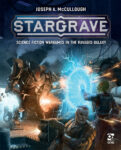
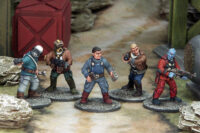
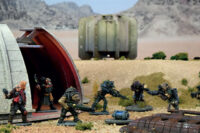
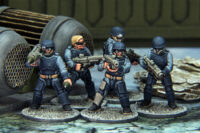
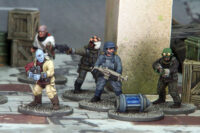
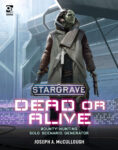
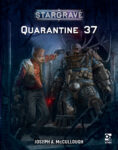
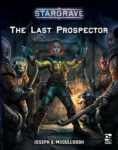












Leave a Reply